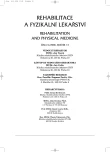-
Medical journals
- Career
Interpretation of the Course of Motor Development Revisited – the Newborn Period and Holokinetic Stage
Authors: I. Vařeka 1,2
Authors‘ workplace: Lázně Luhačovice, a. s. vedoucí lékař prim. MUDr. J. Hnátek 1; Fakulta tělesné kultury UP, katedra fyzioterapie, Olomouc vedoucí katedry prof. MUDr. J. Opavský, CSc. 2
Published in: Rehabil. fyz. Lék., 13, 2006, No. 2, pp. 74-81.
Category: Original Papers
Overview
The article offers an alternative explanation of the course of motor development of the child, based on the basic biomechanical principles and, especially, learning in different forms and at different levels. It makes it different from the prevailing opinion that the development is given by releasing (maturation) of inherited (genetically determined) motor patterns. The main biomechanical factors are considered here to be the provision of posture against the acting gravitational force and the Bernstein principle of restriction and releasing of DOF. In accordance with that the reactions of the child during the postural tests are described as a reulsts of combination of four main factors: 1) gradually improving ability of controlled strengthening of the body, 2) disappearing of Moro reflex, 3) easing newborn’s flexion hypertonia and 4) the action of the gravitational force. In view of the extent the problem is divided in two independent parts. This first part includes intrauterine development, newborn period and the holokinetic stage of the suckling period.
Key words:
motor pattern, postural reactions, DOF, posture
Labels
Physiotherapist, university degree Rehabilitation Sports medicine
Article was published inRehabilitation & Physical Medicine

2006 Issue 2-
All articles in this issue
- Shoulder Girdle in the Regiment of Quadrupedal Locomotion
- Disorders of Cervicothoracic Junction and Distant Symptoms
- New Knowledge about Structural Prerequisites in Coordination of the Diaphram Function and Belly Muscles
- Relationship betweem Breathing Movements and Posture
- Modulation of Cardiovascular Functions Due to Repeated Coolings of Lower Legs
- Interpretation of the Course of Motor Development Revisited – the Newborn Period and Holokinetic Stage
- Interpretation f the Course of Motor Development Revisited f r om Monokinetic Stage up to Toddler Period
- Rehabilitation & Physical Medicine
- Journal archive
- Current issue
- Online only
- About the journal
Most read in this issue- Relationship betweem Breathing Movements and Posture
- Disorders of Cervicothoracic Junction and Distant Symptoms
- New Knowledge about Structural Prerequisites in Coordination of the Diaphram Function and Belly Muscles
- Shoulder Girdle in the Regiment of Quadrupedal Locomotion
Login#ADS_BOTTOM_SCRIPTS#Forgotten passwordEnter the email address that you registered with. We will send you instructions on how to set a new password.
- Career

